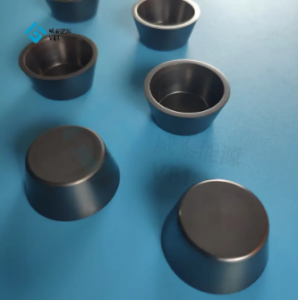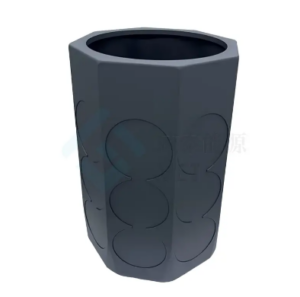ガラスカーボンの可燃性は例外的な熱抵抗および化学安定性による高温環境でExcelを超過します。 炭化ケイ素の残酷とは異なり、摩耗に抵抗し、極端な条件下で性能を維持します。 彼らの先進的なデザインは、グラファイトの残酷性や TACコーティング 残酷、凝固する ガラスカーボン可燃性 耐久および有効な残酷さを要求する企業のための必須の選択として.
要点
非常に熱い条件でガラス カーボン皮はよく働きます。 それらは熱に抵抗し、長く持続し、金属加工および破片製造の企業のためにそれらを大きいようにします.
これらの残酷剤は熱による壊れ目か割れることから材料を停止します。 これらはうまく機能し、交換、時間とお金の節約に必要な頻度を削減します.
化学物質に反応せず、小さな気孔を持っています。 素材は、使用中の材料を純粋に保持し、効率性を高め、厳しい産業タスクを信頼します.
高温用途における熱チャレンジ

材料の分解および摩耗
高温環境は、特に金属を含む産業プロセスで材料の劣化を加速することが多い。 極端な温度への長期暴露は、熱膨張を引き起こし、材料の構造的完全性を低下させる可能性があります。 時間が経つにつれて、これは亀裂、変形、および寿命を削減します。 そのような条件で使用される可分は、運用効率を維持するために、これらのストレスに耐える必要があります。 適切な材料なしで、企業は頻繁な機器の故障に直面し、高価な取り替え。 ガラスカーボンの可燃性は延長された熱露出の下で摩耗への例外的な耐久性そして抵抗を提供することによってこの挑戦に対処します.
熱衝撃および装置の損傷
急激な温度変化により、高温用途での課題が大きく変化します。 突然の冷却か熱は熱衝撃、ひびに導きま装置の完全な失敗を引き起こします。 この問題は頻繁に温度の循環を要求するプロセスで特に共通です。 たとえば、不一致熱交換器は、過熱分解圧力低下、さらなる緊張装置をすることができます。 ガラスカーボン屑のような熱衝撃を扱うように設計されているCruciblesは信頼できる解決を提供します。 熱安定性は、破裂温度の変動中に不正確なままにし、ダウンタイムとメンテナンスコストを削減します.
熱集中的なプロセスの効率
不効率な熱管理はエネルギー廃棄物および高められた操業費用をもたらすことができます。 温度制御システムは、多くの場合、重要なエネルギーを消費し、適切に設計された機器は、この問題を引き起こします。 また、季節変動や周囲温度変動などの外部要因は、熱規制を複雑化します。 Cruciblesは熱集中的なプロセスの最適化に重要な役割を果たします。 ガラスカーボンは、過酷な条件でも、一貫した性能を維持することで効率性を高めます。 極端な温度に耐える能力は、エネルギーの損失を最小限に抑え、コスト削減と環境の持続可能性に貢献します.
ガラス カーボン クラシブルの特性
高い熱抵抗
ガラスカーボン残酷 厳しい産業用途に理想的な高温抵抗を発揮します。 独自の構成により、構造の完全性を損なうことなく極端な熱に耐えることができます。 従来の材料とは異なり、この残酷剤は2000°を超える環境でも性能を維持 ツイート 金属製錬、半導体製造、化学研究など、一貫した結果が得られます.
ガラスカーボン残留物の高温抵抗も熱膨張のリスクを最小限に抑えます。 このプロパティは、割れや変形の可能性を減らし、長期にわたる信頼性の高い性能を保証します。 精密な温度制御を必要とする産業は安全および効率を両方高めるので、この特徴からかなり寄与します.
熱安定性および化学不活性
ガラスカーボン残酷剤の熱安定性は、高度な材料特性から成ります。 重力カーボン、主成分は熱衝撃に抵抗します優秀な熱伝導性が原因で。 この特徴は、残酷剤が破壊することなく迅速な温度変化に耐えることを可能にします.
化学物質の不活性は、その性能をさらに高めます。 材料の低い気孔率はそれに敏感なプロセスの間に汚染を防ぐガスに不浸透させます。 また、塩酸、塩酸、硫酸、硫酸などの積極的な試薬からの攻撃に抵抗します。 この抵抗は、過酷な化学環境でも、最小重量損失と長期信頼性を保証します.
耐久性と寿命
ガラス カーボンの屑はそれらに高力適用のための費用効果が大きい解決をする比類のない耐久性を提供します。 酸化抵抗は、高温で酸素が豊富な環境にさらされた場合の劣化を防ぎます。 このプロパティは、従来の残酷と比較して寿命を大幅に延ばします.
これらの残酷な設計はまた、その傷の抵抗と耐摩擦性を高めます。 これらの特徴は機械的ストレスの下で一貫した性能、を保障します。 冶金や電子機器の製造など、継続的な業務に頼る産業は、頻繁な交換のための減少したニーズの恩恵を受ける.
ガラスカーボン残酷剤は高温抵抗、酸化抵抗および化学安定性を結合し、要求する適用の比類のない性能を提供します。 耐久性と信頼性は、現代の産業プロセスに不可欠です.
ガラス炭素るつぼが熱の課題を解決する方法
材料の劣化を防ぐ
高温環境で材料の劣化を効果的に防ぐガラスカーボン残骸。 独自の組成物は熱膨張に抵抗し、従来の材料の割れや変形につながります。 グラファイトの残酷さとは異なり、時間をかけて摩耗に苦しむかもしれない、ガラスカーボン残酷剤は、極端な熱への長期暴露の下でも、構造的完全性を維持します。 この耐久性は一貫した性能を保障し、取り替えの頻度を減らし、企業のための時間そして資源を両方節約します.
ガラス炭素の残酷性が低く、劣化防止に重要な役割を果たしています。 ガスや液体の吸収を最小限にすることで、汚染を避け、化学的安定性を維持します。 この特徴は、半導体製造や化学研究などの高純度を必要とするプロセスにおいて特に価値があると証明しています.
熱衝撃に耐える
熱衝撃は急速な温度変化を含む適用の共通の挑戦です。 高度な熱特性により、このような条件でガラスカーボン残酷性が優れています。 重力カーボン、第一次材料は、優秀な熱伝導性を、それを熱を均等に分配し、抜かれた温度変動の間にひびに抵抗することを可能にします.
グレード 1000°を超える動作温度でも、熱サイクル中に激しいカーボンが安定しています。 ツイート.
材料の弾性は、金属鋳造やエピタキシャル成長などの鋭い温度変化のプロセスに適しています.
熱衝撃に耐えるこの能力は途切れない操作を保障し、装置のダウンタイムを最小にします。 精密な熱制御に頼る企業はガラス カーボン残酷の信頼性からかなり寄与します.
Enhancing Process Efficiency
ガラスカーボンは熱管理を最適化することによって熱集中的なプロセスの効率を高めます。 それらの高い熱抵抗はそれらが2000°を越える環境で一貫した性能を、維持することを可能にします ツイート この機能は、エネルギー損失を削減し、均一な加熱を保証します。これは、金属製錬や連続鋳造などのプロセスに不可欠です.
可燃剤の耐薬品性は、さらなる効率性に貢献します。 積極的な化学薬品との反作用に抵抗することによって、それらは汚染を防ぎ、処理される材料の純度を維持します。 この特徴は、精密や清潔さがパラマウントされている電子製造などの業界で特に有利です.
また、ガラスカーボン残留物の堅牢な設計により、摩耗や破損を最小限に抑え、頻繁な交換の必要性を軽減します。 この長寿は、運用コストを削減し、生産性を向上させ、現代の産業用途に欠かせないツールです.
ガラスカーボン用医薬品の用途と利点
冶金・金属加工
ガラス炭素の残骸は冶金学および金属の処理で重要な役割を担います。 それらの高熱抵抗は、構造の完全性を損なうことなく、極端な温度で溶融金属を処理することを可能にします。 製錬、製錬、合金製造などの工程で欠かせません。 これらの残留物の化学的不活性は、金属加工中に不要な反応が起こらないことを保証し、最終製品の純度を維持します.
重要な摩耗なしで繰り返された使用に抗するので、これらの残酷の耐久性からの産業利益。 酸化に抵抗する能力は、その長寿をさらに高め、それらを継続的な操作のための費用効果が大きい選択にします。 一貫した性能を維持することで、金属加工設備の効率化とダウンタイム削減に貢献します.
半導体・電子製造
半導体・電子機器の製造では、ガラスカーボンの可燃物は、ハイテクなアプリケーションに必要な純度と精度を保証します。 彼らはいくつかの重要なプロセスで不可欠です
結晶成長: : : Czochralskiプロセスをサポートし、シリコンやゲルマニウムなどの高純度材料の成長を可能にします.
ドーピングプロセス: : : それらはドーピングの間に材料の溶け、混合を促進しまプロセスを妥協しない汚染物質を保障します.
エピタキシャル成長: 半導体層の堆積中に、これらの残留物は、ソース材料の完全性を維持します.
ガラスカーボンの可燃性の化学安定性そして低い気孔率は汚染を防ぎ、それらに高純度材料を作り出すために理想的にします。 極端な温度に耐える能力は、厳しい製造環境での信頼性を保証します.
化学加工・研究
厳しい条件に耐えることができる化学処理および研究の要求材料。 積極的な化学薬品および高温への抵抗によるこれらの設定のガラス カーボン残骸のExcelは。 これらは、酸、アルカリ、その他の腐食性物質を含む用途で広く使用されています.
研究者は、高純度材料を必要とする実験のために、これらの残留物に依存し、低気孔率は汚染を防ぎます。 熱安定性は温度に敏感なプロセスの正確な結果を保障します。 ガラスカーボン残酷剤の耐久性は頻繁に取り替えのための必要性を減らします、それらに実験室および産業化学処理のための実用的な選択をします.
ガラス炭素の残留物の多様性は、冶金学から高度な電子機器や化学研究に至るまで、産業の礎となります。 独自の特性により、高温用途における効率性、信頼性、コスト効率性が向上します.
高温環境での熱課題に対する高度なソリューションを提供します。 耐熱性・耐薬品性は、冶金や半導体製造などの業界に欠かせないものとなっています。 グラファイトの残酷とは異なり、摩耗や熱衝撃に抵抗し、長期的な信頼性を保証します。 これらは、効率性を高め、リスクを削減し、要求する産業プロセスをサポートします.
よくあるご質問
従来の代替品よりもガラスカーボン残酷剤は?
ガラスカーボン残酷剤は、比類のない耐熱性、耐薬品性、耐久性を提供します。 これらの特性はグラファイトか炭化ケイ素のような従来の材料を越える高温適用の信頼できる性能を保障します.
ガラス カーボン残酷剤は急速な温度変化を扱うことができますか?
はい、効果的に熱衝撃に耐えるガラス カーボン残骸。 高度の熱安定性は急流の温度変動の間のひびを防ぎま、産業プロセスを要求する無停電操作を保障します.
ガラスカーボンは化学研究に適していますか?
化学研究のガラスカーボン残骸のエクセル。 積極的な化学薬品への低い気孔率そして抵抗は材料純度を維持し、それらに高精度および信頼性を要求する実験のために理想的にします.







